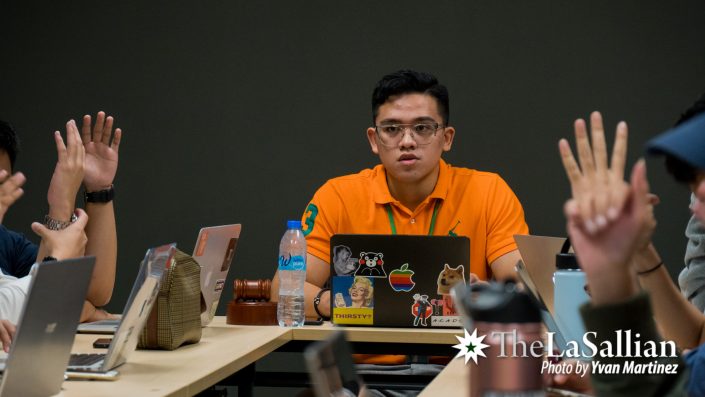A revised University Student Government (USG) Constitution is set to take effect starting next academic year (AY)—assuming that it is ratified by a majority of students in an upcoming plebiscite set to take place during the third term of the current AY.
With the current charter already 10 years old—it was first ratified in 2009—efforts to amend it have been initiated throughout the past decade. Among these was the failed 2014 plebiscite that would have installed a new constitution. In 2017, discussions to have amendments began anew, but it is only this year that any concrete plans to have these approved materialized.
Last November 15, the Legislative Assembly (LA) celebrated its approval of a resolution calling for constitutional amendments and endorsing their draft of a new one. Through a plebiscite, the student body can vote for or against the proposed amendments. However, at least 50 percent plus one of the student population must participate in the vote to validate the plebiscite.
A USG ombud
The USG’s Office of the Ombudsman—the brainchild of then-Chief Magistrate Miguel Adriano, Guillanio Sencio, and then- LA Representative Carl Au—was created in 2012 to help the Judiciary file cases, eventually assuming responsibility over charging and prosecuting USG officials.
Two years later, however, in March 2014, the LA, through an overwhelming majority vote, moved to dissolve the office in a resolution introduced by then-CATCH2T17 LA Representative Patrick Kahn and then-68th ENG LA Representative Binky Suarez. Kahn argued that the office was not “properly defined” in the original 2009 USG constitution.
The office nevertheless demonstrated unignorable influence during its short existence. In January 2014, then-FOCUS2012 LA Representative Nina Cervero was impeached after being charged with gross negligence of duty, out of a complaint filed by the Ombudsman. Cervero was later granted a conditional pardon by then-USG President Migi Moreno. She later issued a public apology. The following February, financial accounts of five USG units—the Office of the Vice President for Internal Affairs, BLAZE2013, FAST2011, FAST2012, and FAST2013—were frozen following a recommendation by the Ombudsman, as said units failed to comply with audit requirements.
Members of the USG did attempt to reinstate the office amid continued corruption allegations against its officials. As early as 2016, then-Chief Magistrate Frances Lim made mention of reintroducing the Ombudsman via an LA resolution; however, it was only in 2018 that the Ombudsman Act was passed by the LA. Co-authored by then-EXCEL2019 LA Representative Lance Dela Cruz, the act formally laid out the body’s mandate and structure. However, the delay of the planned constitutional plebiscite for the AY meant that the measure could not be adopted, leaving the office in limbo.
Finally, in an LA session last November 8, representatives resolved to reinstate the Office of the Ombudsman as an autonomous body, independent from the three branches of the USG. Additionally, a resolution introduced on November 13 strengthened existing guidelines for ombudspersons, formally requiring applicants to have at least a stay of one year left in the University and no record of partisanship.

Role shifts, revisions, budget
Besides the Office of the Ombudsman, roles and organization also became points of contention for the LA. In a session last October 25, Minority Floor Leader Neal Gonzales backed a proposal of a merger wherein the Office of the President (OPRES) would subsume the Office of the Vice President for External Affairs (OVPEA).
According to Gonzales, the proposal stems from similarities in the work conducted by both offices. He highlighted the heavy involvement of the OPRES in external affairs and pointed out that the office revolves around “overseeing” lower offices. “We feel like there should be more responsibility [for the] Office of the President,” Gonzales mentioned.
The proposal was quickly shot down by members of the majority floor, particularly Majority Floor Leader Maegan Ragudo and CATCH2T21 Representative Jaime Pastor. They countered that managing the entirety of USG units is no easy task. In Ragudo’s words, the proposal would just be an additional “burden to the OPRES.”
The LA also passed a resolution that made the impeachment process more difficult—all magistrates are now required to be present during a hearing, as opposed to the old rule that only required two-thirds to be present to impeach an official.
But continued disagreements between LA members also resulted in the shelving of other proposals, including a resolution advocating for greater “local autonomy” for college governments, backed by BLAZE2020 LA Representative Urban Teh.
The tedious pace of initial discussions met the ire of some members of the Assembly. Chief Legislator Will De Castro voiced his frustration during a session last October 18, when representatives only managed to produce two amendments. “May deadline tayo. Hindi natin aabutin ‘yun kung ganito tayo. There are more than 20 articles in the Constitution [to be tackled],” he declared.
(We have a deadline. We will not reach it if we are like this.)
Toward ratification
Ragudo—one of the proponents of the resolution calling for the charter change—confirmed that the plebiscite is set to take place during the next General Elections.
She said that campaigning for the plebiscite will occur throughout the entire AY, with the LA and the USG Executive Board spearheading the effort. “We’ll be coordinating more with the Executive Board on that. I’m pretty sure na magre-release sila ng statements and announcements every now and then on that for the constitution plebiscite,” Ragudo added.
Gonzales, the co-proponent of the measure, also hoped that political parties would assist them in the campaign.
But to be successful, the initiative will have to avoid a repeat of the previous plebiscite held in 2014, which was unable to attain the required voter turnout. Only 8.49 percent of the student population voted that year.
